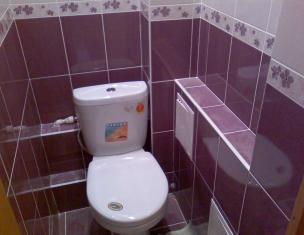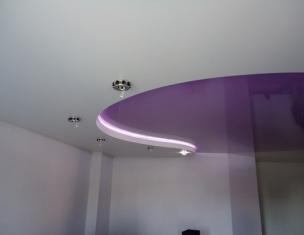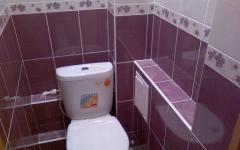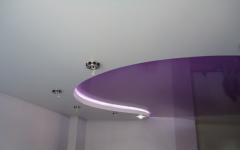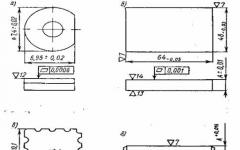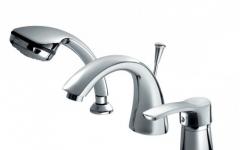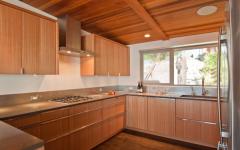The range hood is one of the most important electrical appliances in the kitchen. With its help, it is possible to equip the room with a comfortable microclimate. There are several types of hoods, differing in the principle of operation and appearance. We suggest that you familiarize yourself with the recommendations on how to install the hood with your own hands.
Cooker hoods: varieties and characteristics
In relation to the principle of operation, kitchen hoods are evacuating and circulating. The first option involves the ejection of air from the room to the outside. Extractors of the second type - transport air through filters and return it back. Installing an activated carbon filter is able to turn the evacuating hood into a circulating one.
The circulation hood does not affect the operation of the ventilation system, however, it is less popular in use, primarily because of its high cost.

In relation to the place of installation, hoods are built-in, for example, in a closet, desktop, fireplace, ceiling, island. The desktop version of the hoods is used very rarely in everyday life; such devices are most often an attribute of professional kitchens.
To design a chimney hood, you should hire specialists who will draw up an individual drawing of this device. This hood has an attractive appearance and high cleaning speed. Ceiling type hood implies the presence on the ceiling of several air intake elements that help purify the air. However, in order to install such a system, it is necessary to equip a false ceiling, under which there is an air intake system.
The simplest and easiest to use hood option for a standard kitchen in an apartment or in a private house is its built-in version or a wall-mounted hood.
Installing a hood in the kitchen: features of choosing an electrical appliance
When choosing a hood for your home, you should study certain criteria that will help you choose a device that has good performance characteristics. The hood for the kitchen is exposed to moisture, grease, vapors, so it must first of all be electrically safe. The settling of moisture and fat inside the device contributes to electrical malfunctions of the fan.
In any case, three cables are used to connect the device to the electrical network, one of which is grounding.
If there is grounding in the house, it is enough to connect the wires together. However, if there is no grounding, then you need to take care of its arrangement.

In order to connect the ground, it is strictly forbidden to use gas, water and other pipes. For these purposes, a deaf neutral is used.
When buying a hood for the kitchen, first of all, focus on its performance. The efficiency of the device directly depends on this indicator. The hood should provide a change of all the air in the room for an hour. To calculate the optimal performance of the hood, the area of \u200b\u200bthe room is multiplied by its height and by twelve. The resulting value is multiplied by 1.3.
The width of the device must be the same as the hob or greater, but in no case less. Also, focus on the versatility of the device. There are hoods that operate in different modes. When buying a hood with filters, get a few spare filters that will need to be changed if necessary. A more efficient option is to use an extractor hood that removes polluted air from the room without returning it.

However, when choosing a hood with a filter, ask about their number and features. Some filters are capable of providing coarse cleaning, while others are capable of fine cleaning. The first option involves a reusable mesh, to remove fat from which it is enough to wash it. Fine filters contain activated carbon, which provides better air purification.
To control the hood use the usual buttons, sensor or remote control. Mechanical horizontal switches provide slider control of the device. Also, special attention should be paid to the versatility of the device. Some hoods are characterized by different operating modes, have additional sensors and timers. However, if you want to purchase inexpensive equipment, then you can do without them. Almost every hood has a built-in lighting device in the form of a halogen bulb or incandescent lamps.

The effectiveness of the use of hoods in the kitchen is influenced by the following indicators:
- the air pressure created by the motor, from an increase in this indicator, productivity also increases;
- the number of operating modes, the possibility of programmed inclusion;
- grease filters, their dimensions, number and section;
- device performance and power reserve, the hood should provide maximum air purification, for example, when food is burned;
- The size of the hood affects how much air is drawn in by the device.
Do-it-yourself kitchen hood installation
Installation of the hood should be carried out taking into account the already existing standard ventilation. There are two ways to remove air - arranging a new additional window to the street or connecting the hood to an existing ventilation shaft.
The second method has a lot of disadvantages, first of all, the hood connected to the ventilation needs to install a check valve. However, in some cases, the air removed from the kitchen is returned to other rooms.
It is easier and more correct to build an additional window for removing air for the kitchen hood. To ensure that the condensate that forms inside the hood does not lead to malfunctions in its operation, a special damper should be installed, which is most often made of aluminum. At the same time, the size of the window located under the duct should be ¾ of the diameter of the duct. To tighten the damper, a special spring is used, which contributes to its opening in the process of passing air through it. With the help of a spring, the device self-regulates.

Another functional element of the hood is the odor neutralizer. There are three main types of odor neutralizers. Let's take a look at them in more detail:
- air neutralizers of chemical origin - they need to be replaced periodically, as they are negatively affected by fat that gets on the surface of the hood, also, such substances contribute to the rapid depletion of air and in some cases are harmful to human health;
- electric air ionizers - work on the same principle as conventional ionizers, however, they create a larger discharge, since much more odors accumulate over the hood than in an ordinary living room, if a person is constantly above the hob, then the ionizer has a detrimental effect on him;
- ultraviolet-type neutralizers - they need periodic cleaning and lamp replacement, however, this is the only neutralizer option that is environmentally friendly for humans, and with the help of lamps it is possible not only to solve the issue of air purification, but also to illuminate the hob.
Air duct for exhaust: features and characteristics
Most often, corrugated ducts are used for exhaust, this is due to their affordable cost and ease of installation. There are also air ducts made of plastic or metal, they have a section in the form of a circle, square or rectangle.
If the kitchen has high ceilings, then it is preferable to install a round version of the duct. Rectangular ducts are more versatile and are most often used in the kitchen. If you want to save space in the room, we recommend choosing a flat version of the duct.

In the process of combining various duct options, it is necessary to use special adapters and elbows that will help connect them together. To install a corrugated duct, you do not need to install the above elements. Pay attention to the diameter of the duct, it must be larger than the diameter of the ventilation grilles. Otherwise, there will be an increase in resistance inside the pipe and a decrease in the power of air flows. If these indicators coincide, the noise level from the operation of the hood will be quite high. Also, you should pay attention to the length of the duct, the optimal value will be 300 cm. When using longer ducts, the efficiency of the hood will decrease. It is not allowed to have right angles during the installation of air ducts.
Among the advantages of plastic air ducts, we note:
- low noise performance;
- low level of resistance;
- light weight and easy installation.
The corrugation for the hood is installed using clamps and fittings. Among its advantages we note:
- easy installation;
- affordable cost;
- no need for adapters;
- flexibility.

The most difficult metal air ducts to install. To ensure their tightness, it is necessary to process their joints with a special glue.
In order to hide the duct in the kitchen, use the following recommendations:
- to hide the pipe, a special box or suspended ceiling is installed;
- it is possible to purchase a plastic box, which differs in shape and size, some designs also have built-in lighting, which additionally decorates the room;
- it is possible to install air ducts in kitchen furniture;
- painting the pipe in a color that matches the overall interior is the simplest and at the same time original decor option.
Do-it-yourself kitchen hood installation - technology
Initially, work on installing the hood begins with the manufacture of an anti-return mechanism in the form of a box. This will require sheet aluminum or galvanized steel. An easier option is to purchase a check valve installed in front of the vent. Do-it-yourself installation of a built-in hood in a cabinet is carried out using a jigsaw. To seal the gaps between the hood and the cabinet, foam is used. Initially, the hood is tried on and crackers are made, if necessary.
Next, the hood is installed on the cabinet and its base is marked. To saw off the hole for the hood in the cabinet, use a jigsaw. At the same time, it is initially necessary to drill small holes with a drill, and then cut out the required shape. In this way, it will be possible to prevent damage to the cabinet during the cutting process.
Do-it-yourself installation of an air duct for a kitchen hood is the next work process. Install the corrugated air duct inside the cabinet, cut it to the required length and bend them to the outside.

The hood is installed inside the cabinet, fixed in it with self-tapping screws or dowels. A clamp is used to fix the corrugation.
Installation of air ducts made of plastic is carried out according to the same scheme. However, special adapters are used here to provide corners. Try to keep the pipes under a minimum number of bends. Since one turn implies a loss of approximately ten percent of the power.
Since there is often high humidity in the kitchen, a cabinet made of wood quickly becomes unusable. Therefore, the hood is installed on the wall without it. In this case, you will need a U-shaped frame, for the manufacture of which a metal corner is used. This type of fastening provides support for the body part.
If fixing the hood with ordinary dowels is not possible, then in this case, it is necessary to fix it with self-tapping screws in the form of a stud. Upon completion of installation work, connect the hood to the mains with mandatory grounding and check its operation.
Do-it-yourself kitchen hood installation video:



